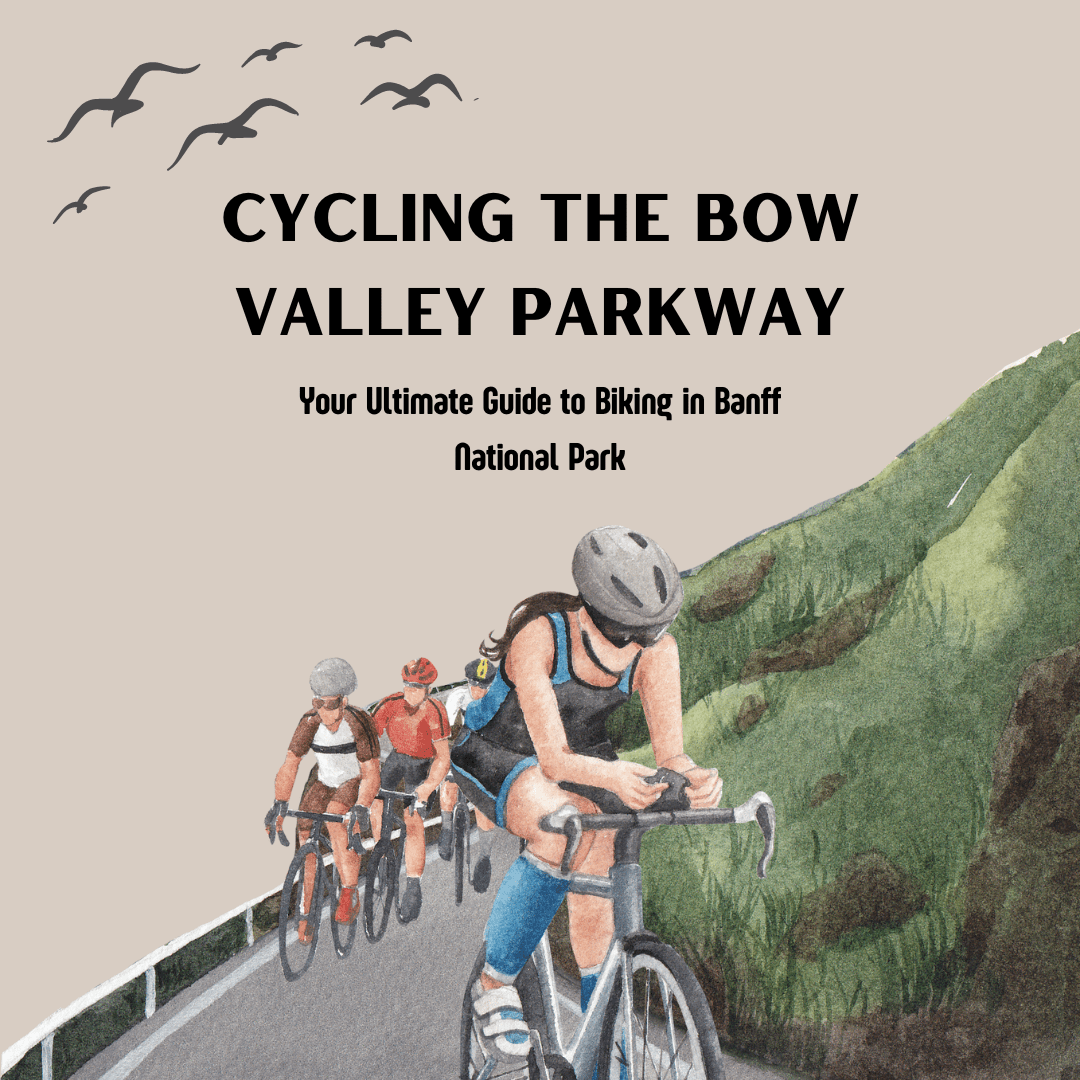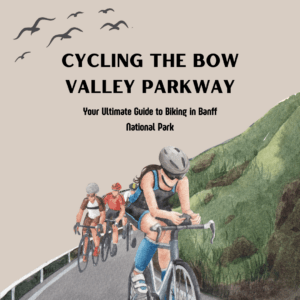
Are you looking for an unforgettable cycling adventure in Banff National Park? Do you want to experience the stunning scenery, diverse wildlife, and historic sites of the Bow Valley Parkway? If so, you’ve come to the right place!
We are the Cycling Team at Johnston Canyon Lodge and Bungalows, a family-owned and operated business since 1926. We are passionate about cycling and sharing our love for this beautiful region with our guests. That’s why we’ve created this guide to help you plan your cycling trip on the Bow Valley Parkway, a scenic winding route between Banff and Lake Louise.
The Bow Valley Parkway, also known as Highway 1A, is a 48-kilometer paved road that parallels the Trans-Canada Highway and connects Banff to Lake Louise. It is a quieter alternative to the main highway, with a reduced speed limit of 60 km/h, impressive views and plenty of roadside pullouts to enjoy. It is also a prime habitat for wildlife in the Bow Valley, thanks to its diverse vegetation, lower elevation and access to plenty of sunshine. You may spot bears, elk, deer, wolves, coyotes, bighorn sheep and more along the way!
What’s new in 2023 for the Bow Valley Parkway?
Starting in 2022, Parks Canada has launched a three-year pilot program to provide an improved cycling experience on the Bow Valley Parkway by restricting vehicle use along the 17 km eastern section of the parkway in the spring and fall. This means that you can cycle this section of the road without public vehicle traffic, making it safer and more enjoyable for cyclists of all levels.
Here are the details on the Bow Valley Parkway Cycling Experience:
- The eastern section of the Bow Valley Parkway (meaning the section from the Trans-Canada Highway to Johnston Canyon) will have restricted public vehicle access in the Spring and Fall.
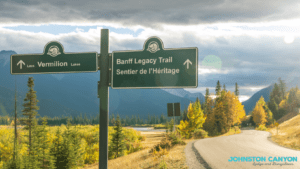
- Each spring from May 1 to June 25 (starting in 2022 and for the three-year pilot), no public vehicles will be allowed on the eastern section of the Bow Valley Parkway between 8 a.m. to 8 p.m.*
- Each fall from September 1 to October 1 (starting in 2022 and for the three-year pilot), no public vehicles will be allowed on the eastern section of the Bow Valley Parkway between 8 a.m. to 8 p.m.*
- The Bow Valley Parkway mandatory seasonal travel restriction also applies to the Bow Valley Parkway Cycling Experience, beginning May 1, 2023 at 8 a.m. Cyclists must abide by the travel restriction and therefore are not permitted access to the Bow Valley Parkway between 8 p.m. and 8 a.m.
- The section of the Bow Valley Parkway east of Johnston Canyon to Banff will remain open to public vehicles EXCEPT from May 1 to June 25 and from September 1 to 30 in 2022, 2023 and 2024 where public vehicles will not be allowed (as part of the three-year cycling pilot on Highway 1A).
*Please note that these dates and times are subject to change depending on weather conditions and wildlife activity. Check with Parks Canada for updates before you go.
Cycling the Bow Valley Parkway Details
Here are some basic information you need to know before you start your cycling adventure on the Bow Valley Parkway:
- Distance: The total distance of the Bow Valley Parkway is 48 km one way. You can choose to cycle as much or as little as you want, depending on your fitness level, time availability and preference. You can also cycle both ways or arrange a shuttle service or taxi for your return trip.
- Elevation gain: The total elevation gain of the Bow Valley Parkway is about 400 m. The road is mostly flat or gently rolling, with some steeper sections near Castle Junction and Lake Louise. The highest point is at Morant’s Curve, where you can enjoy a panoramic view of the Bow River and Mount Temple.
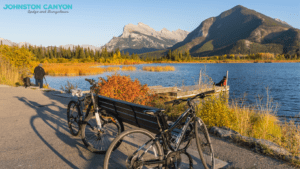
- Difficulty: The difficulty of cycling the Bow Valley Parkway depends on your experience, skill and stamina. Generally speaking, it is an easy to moderate ride for most cyclists, especially if you take advantage of the car-free sections in spring and fall. However, if you are new to cycling or have limited fitness, you may find some parts challenging or tiring. We recommend that you start slow, take breaks as needed and enjoy the journey at your own pace.
- Duration: The duration of cycling the Bow Valley Parkway varies depending on how far you go, how fast you ride and how often you stop. As a rough estimate, it can take anywhere from two to six hours one way. We suggest that you plan ahead, check the weather forecast and leave enough time for sightseeing, wildlife watching and resting along the way.
- Bike type: The Bow Valley Parkway is suitable for any type of bike, as long as it is in good condition and fits you well. You can use a road bike, a mountain bike, a hybrid bike or an e-bike. E-bikes are becoming increasingly popular because of the availability of bike rentals in Banff and the ease of riding uphill. However, please note that e-bikes are not allowed on trails in Banff National Park, only on roads.
Best Time to Cycle the Bow Valley Parkway
The best time to cycle the Bow Valley Parkway depends on your personal preference and what you want to see and do along the way. Here are some factors to consider:
- Season: The Bow Valley Parkway is open year-round, but the cycling conditions vary depending on the season. Spring and fall are ideal for cycling the car-free sections of the road, as well as enjoying the changing colors of the landscape. Summer is the busiest and warmest season, with more traffic, tourists and wildlife activity. Winter is the quietest and coldest season, with snow and ice on the road, requiring snow cleats or fat bikes.
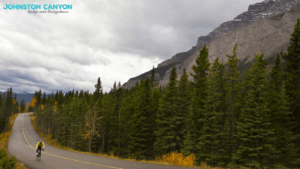
- Time of day: The time of day you choose to cycle the Bow Valley Parkway can affect your experience in terms of traffic, temperature and wildlife. Early morning and late afternoon are usually the best times to avoid crowds, enjoy cooler weather and increase your chances of seeing wildlife. Midday is typically the busiest and hottest time, with more vehicles, people and noise on the road. Nighttime is not recommended for cycling, as it is dark, cold and potentially dangerous due to wildlife presence.
- Weather: The weather in Banff National Park can be unpredictable and change quickly, so it is important to check the forecast before you go and be prepared for any situation. Dress in layers, wear sunscreen, sunglasses and a helmet, bring water, snacks and a first aid kit, and carry a rain jacket or a warm coat in case of rain or snow.
Parking for Cycling the Bow Valley Parkway
If you are driving to the Bow Valley Parkway, you will need to find a place to park your vehicle before you start your cycling trip. Here are some options:
- Banff Train Station parking lot: This is the recommended parking option for cyclists who want to access the car-free section of the Bow Valley Parkway in spring and fall. The parking lot is located at the Banff Train Station, accessible via the Mount Norquay Road entrance to the townsite. From there, you can cycle along Vermilion Lakes Drive (5 km) or take the Banff Legacy Trail (6 km) to reach the Fireside Day-use Area, where the car-free section begins.
- Fireside Day-use Area: This is another parking option for cyclists who want to access the car-free section of the Bow Valley Parkway in spring and fall. The day-use area is located at the junction of Highway 1A and Highway 1 (Trans-Canada Highway), about 6 km west of Banff. However, this parking lot has limited space and may fill up quickly during peak times.
- Johnston Canyon Day-use Area: This is a parking option for cyclists who want to access the open section of the Bow Valley Parkway between Johnston Canyon and Lake Louise. The day-use area is located at Johnston Canyon, about 22 km west of Banff. From there, you can cycle westward along Highway 1A to Lake Louise (26 km) or eastward to Castle Junction (13 km). Bike racks are available at Johnston Canyon Day-use Area. Make sure to bring your own lock.
- Castle Junction Day-use Area: This is another parking option for cyclists who want to access the open section of the Bow Valley Parkway between Johnston Canyon and Lake Louise. The day-use area is located at Castle Junction, about 35 km west of Banff. From there, you can cycle westward along Highway 1A to Lake Louise (13 km) or eastward to Johnston Canyon (13 km).
Bow Valley Parkway Map
Here is a map of the Bow Valley Parkway showing its route, distance markers, parking areas and places to stop along the way.
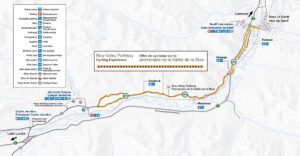
Places to Stop Along the Bow Valley Parkway
One of the best things about cycling the Bow Valley Parkway is that there are many places to stop along the way to enjoy nature, history and culture. Here are some of our favorite places to stop on Highway 1A:
- Vermilion Lakes: These are three shallow lakes located along Vermilion Lakes Drive, a scenic road that connects Banff Train Station parking lot with Highway 1A. They offer stunning views of Mount Rundle, Sulphur Mountain and Cascade Mountain, especially at sunrise or sunset. They are also home to various birds and animals, such as
- Johnston Canyon Lodge and Bungalows: This is our home base and the ideal place to start or end your cycling trip on the Bow Valley Parkway. We offer 42 heritage bungalow/cabin accommodations in a variety of sizes and amenities. Within the lodge, you can enjoy a delicious meal at the Blackswift Bistro, which serves fresh and local cuisine with a modern twist. You can also treat yourself to some ice cream and espresso at the Market Cafe, where you can find souvenirs, snacks and supplies. We are conveniently located at the trailhead of historic Johnston Canyon, a must-see natural attraction in Banff National Park. The trail boasts over 7 cascading glacial waterfalls experienced from a series of suspended canyon catwalks, bridges and caves. You can walk to the lower falls (1 km) or the upper falls (2.7 km) from our lodge, or rent a bike and explore further to the Ink Pots (5.8 km), a group of turquoise pools fed by underground springs.
- Castle Mountain Viewpoint: This is a scenic pullout along Highway 1A near Castle Junction, where you can admire the impressive Castle Mountain and its reflection in the Bow River. Castle Mountain is one of the most iconic peaks in Banff National Park, with its distinctive shape and colorful layers of rock. It was named in 1858 by James Hector, a member of the Palliser Expedition, who thought it resembled a castle. However, in 1946, it was renamed Mount Eisenhower in honor of Dwight D. Eisenhower, the American general and president. This caused some controversy among Canadians, who preferred the original name. In 1979, a compromise was reached: the main peak was restored to Castle Mountain, while a tower on the southeast face was named Eisenhower Peak.
- Baker Creek Picnic Area: This is a lovely picnic area along Highway 1A near Baker Creek Mountain Resort, where you can relax by the creek and enjoy a bite to eat. The picnic area has tables, fire pits, toilets and garbage bins. You can also access some hiking trails from here, such as the Baker Creek to Protection Mountain Campground Trail (3 km) or the Baker Creek to Morant’s Curve Trail (2 km). Baker Creek is named after Jim Baker, a prospector who discovered gold in the area in 1897. He built a cabin near the creek, which is alongside the resort.
- Morant’s Curve: This is another scenic pullout along Highway 1A near Lake Louise, where you can witness one of the most photographed views in Canada. Morant’s Curve is a bend in the Bow River where the Canadian Pacific Railway runs parallel to it, with Mount Temple and other peaks in the background. It was named after Nicholas Morant, a photographer who worked for the railway company from 1929 to 1981. He took many pictures of this spot, especially when steam locomotives were still in use. Today, you can still see trains passing by this curve, creating a contrast between nature and technology. You can learn more about the history of the railway and its impact on Banff National Park from the interpretive signs at this pullout.
We hope this section has helped you find more information on cycling the Bow Valley Parkway! If you have any questions or need more information, please contact us at [email protected]. We are the Adventure Team at Johnston Canyon Lodge and Bungalows, and we offer a variety of accommodation options, activities and tours in Banff National Park. We would love to host you and make your stay memorable! 😊
